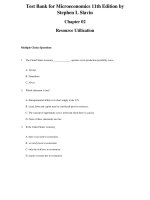Lecture Economics (6/e): Chapter 30 - Stephen L. Slavin
Bạn đang xem bản rút gọn của tài liệu. Xem và tải ngay bản đầy đủ của tài liệu tại đây (362.78 KB, 40 trang )
Chapter 30
Rent, Interest, and Profit
Copyright 2002 by The McGrawHill Companies, Inc. All rights reserved.
301
Chapter Objectives
• What is land?
• Economic rent
• Are prices high because rents are high, or are rents
high because prices are high?
• What is capital?
• How is the interest rate determined?
• The net productivity of capital
• The capitalization of assets
• The present value of future income
• How are profits determined?
• Theories of profit
Copyright 2002 by The McGrawHill Companies, Inc. All rights reserved.
302
What Is Rent?
• What is land?
– Land is a resource or a factor of production
– The owner of land is paid rent for allowing
its use in the production process
– The amount of rent paid for a piece of land
is based on the supply of and the demand for
land
Copyright 2002 by The McGrawHill Companies, Inc. All rights reserved.
303
What Is Land?
• Land is land
• How land is used depends on its location,
its fertility, and whether it possesses any
valuable minerals
• Sometimes we confuse land with what is
built on it
– Land with an apartment building on it will
rent for more than a vacant lot
• However in economic terms we pay rent on the
land itself
Copyright 2002 by The McGrawHill Companies, Inc. All rights reserved.
304
How Does One Piece of Land
Differ From Another?
• A plot of land may have a few alternative
uses
• If it is used at all, it will be used by the
highest bidder – the one willing to pay
the most for it
• The basic way one piece of land differs
from another is location
– An acre of land in the middle of a desert is
worth a lot less than an acre of land in a
metropolitan area
Copyright 2002 by The McGrawHill Companies, Inc. All rights reserved.
305
How Is the Supply of Land
Arrived at?
• In economics we say the supply of land is
fixed
• We can make more efficient use of land
• We represent the supply of land as a
vertical line
Copyright 2002 by The McGrawHill Companies, Inc. All rights reserved.
306
How Is the Demand for Land
Derived?
• The demand for land, like the demand
for labor and capital, is derived from a
firm’s MRP curve
• The land will go to the highest bidder
• The demand curve for land slopes
downward to the right because its
marginal physical product declines with
output (due to diminishing returns)
– If the firm is an imperfect competitor, it
must lower price to increase sales, thereby
further depressing MRP as output expands
Copyright 2002 by The McGrawHill Companies, Inc. All rights reserved.
307
Determination of Rent
S
10,000
The demand for rent is the MRP
schedule of the highest bidder for a
specific piece of land. The supply of
land is fixed, so its supply curve is
perfectly inelastic. The rent, like the
price of anything else, is set by
supply and demand
8,000
6,000
D
4,000
2,000
Amount of land
Copyright 2002 by The McGrawHill Companies, Inc. All rights reserved.
308
Increase in Demand for Land
S
200,000
Since the supply of land is perfectly
inelastic, an increase in demand is
reflected entirely in an increase in
price (and not an increase in the
quantity of land).
160,000
120,000
D2
80,000
D1
40,000
Amount of land
Copyright 2002 by The McGrawHill Companies, Inc. All rights reserved.
309
Economic Rent
• Economic rent is payment in excess of
what people would be willing to accept
• Rent paid to landlords (exclusive of any
payment for buildings and property
improvement ) is, by definition, economic
rent
Copyright 2002 by The McGrawHill Companies, Inc. All rights reserved.
3010
Are Prices High Because Rents Are
High, or Are Rents High Because
Prices Are High?
• High rents don’t cause high prices
• Desirable locations attract many prosperous
renters, who bid up rents because they believe
they will get a lot of business
• Rents are high because the demand for the final
product(s) – and consequently the derived
demand – is high
• If low rents lead to low prices mom and pop
stores would have lower prices, but they have
higher prices
Copyright 2002 by The McGrawHill Companies, Inc. All rights reserved.
3011
Capital
• What is capital
– Capital consists of office buildings, factories,
stores, machinery and equipment, computer
systems, and other synthetic goods used in
the production process
– When we invest we are spending money on
new capital
– The stock of capital increases by means of a
flow of investment
• Say you have a capital stock of four machines. You buy
two more. That’s your investment for the year. Now you
have a capital stock of six machines
Copyright 2002 by The McGrawHill Companies, Inc. All rights reserved.
3012
How Is the Interest Rate
Determined?
The interest rate is determined by
the demand for loanable funds and
the supply of loanable funds
S
16
14
12
10
8
6
D
4
2
Q1
Quantity of loanable funds
The supply of loanable funds (or savings) slopes upward to the right because the
amount of money people save is somewhat responsive to interest rates
Copyright 2002 by The McGrawHill Companies, Inc. All rights reserved.
3013
Interest Rates and Consumer Loans
• High interest rates deter borrowing for
consumer loans
• Banks arguably charge too much on
credit card loans
• Should this justify a legal ceiling (usury
laws) on the interest that may be charged
on these and other loans?
Copyright 2002 by The McGrawHill Companies, Inc. All rights reserved.
3014
Usury Laws
• Usury laws place limits on how much
interest may be charged
• Usury laws are price ceilings because
they prevent the interest rates from
rising to their equilibrium level
– This creates a shortage of loanable funds
Copyright 2002 by The McGrawHill Companies, Inc. All rights reserved.
3015
Usury Laws
• How do usury laws hurt borrowers?
– Since usury laws create a shortage of
loanable funds, the funds that are available
go to the most creditworthy individuals and
businesses first
– Borrowers with poor credit ratings are
completely left out
• These borrowers are left with consumer finance companies
that may not be subject to usury laws
• This means that if they can find money to borrow they will
end up paying much higher interest rates than without
usury laws
Copyright 2002 by The McGrawHill Companies, Inc. All rights reserved.
3016
Interest Rate Ceiling
S
36
32
28
24
20
Ceiling
16
12
8
D
4
100 200 300 400 500 600 700 800
Quantity of loanable funds (in $billions)
Shortage of $350 billion
Copyright 2002 by The McGrawHill Companies, Inc. All rights reserved.
3017
Determination of the Level of Investment
Net Productivity of Capital
The net productivity of capital
is, in effect, a firm’s MRP
schedule. In this case, given
this firm’s net productivity of
capital, it would borrow $40
million if the interest rate
were 10 percent. The lower
the interest rate, the more that
would be borrowed and
invested
24
22
20
18
Net productivity
of capital
16
14
12
10
8
6
4
2
10
20
30
40
50
60
Amount of investment (in $millions)
Copyright 2002 by The McGrawHill Companies, Inc. All rights reserved.
3018
The Net Productivity of Capital
• Economist have developed the concept of
net productivity of capital, which
translates into the expected profit rate
– Subtract all cost (including an allowance for
a normal profit) from sales. This give us the
dollar value of net productivity
– Assuming this value is positive, we divide it
by capital cost to give us the net productivity
of capital, which we express as a percentage
Copyright 2002 by The McGrawHill Companies, Inc. All rights reserved.
3019
The Net Productivity of Capital
Find the net productivity of capital if sales = $150,000; labor cost = $30,000; raw
materials = $10,000; fuel and maintenance = $5,000; normal profit = $5,000; and
capital cost = $80,000
Sales $ 150,000
$130,000
Total Cost
$ 20,000
________ x
Dollar value of net productivity
Labor cost $30,000
Raw materials 10,000
Fuel and Maintenance 5,000
Normal Profit
5,000 Capital cost
80,000 Total Cost
$130,000
Copyright 2002 by The McGrawHill Companies, Inc. All rights reserved.
3020
The Net Productivity of Capital
Find the net productivity of capital is sales = $150,000; labor cost = $30,000; Raw
materials = $10,000; Fuel and maintenance = $5,000; Normal profit = $5,000; and
Capital Cost = $80,000 ( are included in Total Cost)
Sales $ 150,000
$ 130,000
Total Cost
$ 20,000
________ x
Dollar value of net productivity
Dollar value of net productivity ($20,000)
= Net productivity of capital (25
Capital cost ($80,000)
percent)
You would invest right up the point (or just short of the point) at which the
interest rate equals the net productivity of capital
Copyright 2002 by The McGrawHill Companies, Inc. All rights reserved.
3021
The Capitalization of Assets
• The capitalization of assets is just an alternate
way of dealing with capital investment
• This concept enables a business firm to make a
decision about purchasing a capital asset
• To make this decision a firm needs to know
what is the value of that asset
– To do this the firm must also know what the current
interest rate is
Copyright 2002 by The McGrawHill Companies, Inc. All rights reserved.
3022
Value of Asset
How much is the value of a building that provides an annual income
of $200 when the going rate of interest is 8%?
Copyright 2002 by The McGrawHill Companies, Inc. All rights reserved.
3023
Value of Asset
How much is the value of a building that provides an annual income
of $200 when the going rate of interest is 8%?
Annual income from asset
Value of asset =
Interest rate
Copyright 2002 by The McGrawHill Companies, Inc. All rights reserved.
3024
Value of Asset
How much is the value of a building that provides an annual income
of $200 when the going rate of interest is 8%?
Annual income from asset
$200
Value of asset = = = $2,500
Interest rate
.08
If the interest rate rises, the value of an asset falls. If the interest
rate falls, the value of an asset rises.
Copyright 2002 by The McGrawHill Companies, Inc. All rights reserved.
3025









